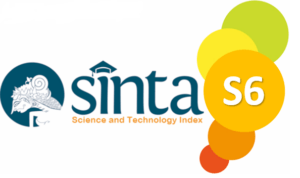RESPON PERKECAMBAHAN BENIH PADI (Oryza sativa L.) VARIETAS LOKAL KABUPATEN PADANG PARIAMAN HASIL IRADIASI SINAR GAMMA
DOI:
https://doi.org/10.31933/ejpp.v4i1.987Keywords:
Mutation Induction, Gamma Irradiation, Local RiceAbstract
Gamma ray irradiation is a mutagenesis method used to obtain new genetic variations in plants, including rice. Local varieties were chosen because they have good adaptability to the local environment and can play an important role in increasing agricultural productivity. The local varieties of rice seeds from Padang Pariaman Regency used in the research were "Madang Pulau", "Putiah Papanai" and "Banang Kuniang". The irradiation doses used were 100 Gy, 200 Gy, 300 Gy, 400 Gy, 500 Gy and 600 Gy. Seeds without irradiation were also used as controls. The results showed that the germination response of local varieties of rice seeds to gamma ray irradiation varied depending on the dose given. In terms of germination percentage, the irradiation dose of 100 Gy showed a significant increase compared to the control in the white Papanai variety. However, irradiation doses of 200 Gy and 300 Gy caused a significant reduction in germination percentage compared with the control. Apart from that, observations were also made on other parameters such as seedling height and root length. The results showed that at irradiation doses of 100 Gy, 200 Gy and 300 Gy, there was a significant reduction in these parameters. Based on these findings, it can be concluded that the use of gamma rays as an irradiation method can influence the germination response of local varieties of rice seeds in Padang Pariaman Regency differently depending on the dose and the variety used.
References
Abdel-Hady, M. S., Okasha, E. M., Soliman, S. S. A., & Talaat, M. (2008). Effect of Gamma Radiation and Gibberellic Acid on Germination and Alkaloid Production in Atropa belladonna. Australian Journal of Basic and Applied Sciences, 2(3), 401–405.
Abdelnour-Esquivel, A., Perez, J., Rojas, M., Vargas, W., & Gatica-Arias, A. (2020). Use of gamma radiation to induce mutations in rice (Oryza sativa L.) and the selection of lines with tolerance to salinity and drought. In Vitro Cellular and Developmental Biology - Plant, 56(1), 88–97.
Ahloowalia, B. S., Maluszynski, M., & Nichterlein, K. (2004). Global impact of mutation-derived varieties. Euphytica, 135(2), 187–204. https://doi.org/10.1023/B:EUPH.0000014914.85465.4f
Al-Mamari, A.-G. H. K., & Ghanim, A. M. A. (2018). Mutation Induction For Sorghum And Rice Using Gamma and X-Ray Radiations. In Plant Mutation Breeding and Biotechnology (p. 139). IAEA-CN-263-256.
Ali, J., & Wani, S. H. (2021). Physiological, Molecular Breeding and Genetic Perspectives. Rice Improvement. Switzerland: Springer Nature Switzerland. https://doi.org/10.1007/978-3-030-66530-2_7
Aynehband, A., & Afsharinafar, K. (2012). Effect of gamma irradiation on germination characters of amaranth seeds. European Journal of Experimental Biology, 2(4), 995–999.
Baldwin, J., & Grantham, V. (2015). Radiation hormesis: Historical and current perspectives. Journal of Nuclear Medicine Technology, 43(4), 242–246. https://doi.org/10.2967/jnmt.115.166074
Chaudhuri, S. K. (2002). A simple and reliable method to detect gamma irradiated lentil (Lens culinaris Medik.) seeds by germination efficiency and seedling growth test. Radiation Physics and Chemistry, 64(2), 131–136. https://doi.org/10.1016/S0969-806X(01)00467-4
CrouthameL, C. E. (1970). Applied Gamma-Ray Spectrometry (Second). Oxford: Pergamon Pres. https://doi.org/10.13182/nse61-a25919
De Micco, V., Arena, C., Pignalosa, D., & Durante, M. (2011). Effects of sparsely and densely ionizing radiation on plants. Radiation and Environmental Biophysics, 50(1), 1–19. https://doi.org/10.1007/s00411-010-0343-8
Efendi, Bakhtiar, Zuyasna, Alamsyah, W., Syamsuddin, Zakaria, S., … Sobrizal. (2017). The Effect of Gamma Ray Irradiation on Seed Viability and Plant Growth of Aceh’s Local Rice (Oryza sativa L.). Advances in Natural and Applied Sciences, 11(3), 91–96.
El-Degwy, I. S. (2013). Mutation Induced Genetic Variability in Rice (Oryza sativa L.). Egyptian Journal of Agronomy, 35(2), 199–209. https://doi.org/10.21608/agro.2013.87
Gaul, H. (1970). Mutagen effects observable in the first generation (Manual on). Vienna: International Atomic Energy Agency.
Gowthami, R., Vanniarajan, C., Souframanien, J., & Arumugam Pillai, M. (2017). Comparison of radiosensitivity of two rice (Oryza sativa L.) varieties to gamma rays and electron beam in M1 generation. Electronic Journal of Plant Breeding, 8(3), 732–741. https://doi.org/10.5958/0975-928X.2017.00111.9
Harding, S. S., Johnson, S. D., Taylor, D. R., Dixon, C. A., & Turay, M. Y. (2012). Effect of Gamma Rays on Seed Germination, Seedling Height, Survival Percentage and Tiller Production in Some Rice Varieties Cultivated in Sierra Leone. American Journal of Experimental Agriculture, 2(2), 247–255. https://doi.org/10.9734/ajea/2012/820
Haris, A., Abdullah, Bakhtiar, Subaedah, Aminah, & Jusoff, K. (2013). Gamma ray radiation mutant rice on local aged dwarf. Middle East Journal of Scientific Research, 15(8), 1160–1164. https://doi.org/10.5829/idosi.mejsr.2013.15.8.11541
Hong, M. J., Kim, D. Y., Ahn, J. W., Kang, S. Y., Seo, Y. W., & Kim, J. B. (2018). Comparison of radiosensitivity response to acute and chronic gamma irradiation in colored wheat. Genetics and Molecular Biology, 41(3), 611–623. https://doi.org/10.1590/1678-4685-gmb-2017-0189
Jaipo, N., Kosiwikul, M., Panpuang, N., & Prakrajang, K. (2019). Low dose gamma radiation effects on seed germination and seedling growth of cucumber and okra. Journal of Physics: Conference Series, 1380, 1–5. https://doi.org/10.1088/1742-6596/1380/1/012106
Jan, S., Parween, T., Siddiqi, T. O., & Mahmooduzzafar, X. (2012). Effect of gamma radiation on morphological, biochemical, and physiological aspects of plants and plant products. Environmental Reviews, 20(1), 17–39. https://doi.org/10.1139/a11-021
Jankowicz-Cieslak, J., Tai, T. H., Kumlehn, J., & Till, B. J. (2017). Biotechnologies for plant mutation breeding. Switzerland: Springer International Publishing.
Kadhimi, A. A., Zain, C. R. C. M., Alhasnawi, A. N., Isahak, A., Ashraf, M. F., Mohamad, A., … Yusoff, W. M. W. (2016). Effect of irradiation and polyethylene glycol on drought tolerance of MR269 genotype rice (Oryza sativa L.). Asian Journal of Crop Science, 8(2), 52–59. https://doi.org/10.3923/ajcs.2016.52.59
Kodym, A., & Afza, R. (2003). Plant Functional Genomics Methods and Protocols: Physical and chemical mutagenesis. (E. Grotewold, Ed.). USA: Springer International Publishing.
Kuzin, A. M., Vagabova, M. E., & Revin, A. F. (1976). Molecular mechanisms of ionizing radiation stimulating effect on seeds. Activation of RNA synthesis. Radiobiologiia, 16(2), 259–261. https://doi.org/https://doi.org/
Lagoda, P. (2012). Effects of radiation on living cells and plants. (B. P. and In Shu, Q.Y., Forster & H. Nakagawa, Eds.) (Plant Muta). UK: CABI.
Marcu, D., Damian, G., Cosma, C., & Cristea, V. (2013). Gamma radiation effects on seed germination, growth and pigment content, and ESR study of induced free radicals in maize (Zea mays). Journal of Biological Physics, 39(4), 625–634. https://doi.org/10.1007/s10867-013-9322-z
Pradhan, B., Baral, S., Patra, S., Behera, C., Nayak, R., MubarakAli, D., & Jena, M. (2020). Delineation of gamma irradiation (60Co) induced oxidative stress by decrypting antioxidants and biochemical responses of microalga, Chlorella sp. Biocatalysis and Agricultural Biotechnology, 25(April), 101595. https://doi.org/10.1016/j.bcab.2020.101595
Ramchander, S., Ushakumari, R., & Pillai, M. R. (2015). Lethal dose fixation and sensitivity of rice varieties to gamma radiation. Indian Journal of Agricultural Research 2015, 49(1), 24–31.
Riviello-Flores, M. de la L., Cadena-Iñiguez, J., Ruiz-Posadas, L. del M., Arévalo-Galarza, M. de L., Castillo-Juárez, I., Hernández, M. S., & Castillo-Martínez, C. R. (2022). Use of Gamma Radiation for the Genetic Improvement of Underutilized Plant Varieties. Plants, 11(1161), 1–19.
Sari, H. P., Suliansyah, I., Dwipa, I., & Hervani, D. (2023). Orientasi Dosis Iradiasi Efektif Pada Perbaikan Genetik Padi (Oryza sativa L.) Lokal Padang Pariaman Melalui Mutasi Induksi. Jurnal Produksi Tanaman, 11(6), 408–421. https://doi.org/10.21776/ub.protan.2023.011.06.08
Sathesh-Prabu, C., & Lee, Y.-K. (2016). Genetic Variability and Proteome Profiling of a Radiation Induced Cellulase Mutant Mushroom Pleurotus florida. Polish Journal of Microbiology, 65(3), 271–277.
Shu, Q. Y., Forster, B. P., & Nakagawa., H. (2012). Plant Mutation Breeding and Biotechnology. London: CABI.
Sparrow, A. H. (1961). Types of ionizing radiations and their cytogenetic effects (Mutation). NAS-NRC.
Tabasum, A., Cheema, A. A., Hameed, A., Rashid, M., & Ashraf, M. (2011). Radio sensitivity of rice genotypes to gamma radiations based on seedling traits and physiological indices. Pakistan Journal of Botany, 43(2), 1211–1222.
Tatar, I., Shamsiah, A., & Rahim, H. A. (2020). In vitro screening of gamma irradiated rice variety MR263 for drought tolerance using polyethylene glycol. Food Research, 4(5), 11–20. https://doi.org/10.26656/fr.2017.4(S5).008
Untari, Y., Efendi, & Sabaruddin. (2021). Effect Of Gamma Ray Irradiation And Harvesting Age On Viability And Vigor Of M2 Mutant Rice (Oryza sativa L) Seeds. IOSR Journal of Agriculture and Veterinary Science, 14(3), 49–53. https://doi.org/10.9790/2380-1403024953
USDA. (2023). World agricultural production. Global Market Analysis. WAP 3-23. https://doi.org/10.32317/2221-1055.201907059
Volkova, P. Y., Bondarenko, E. V., & Kazakova, E. A. (2022). Radiation hormesis in plants. Current Opinion in Toxicology, 30.
Downloads
Published
How to Cite
Issue
Section
License
Copyright (c) 2023 Henny Puspita Sari

This work is licensed under a Creative Commons Attribution 4.0 International License.
Penulis yang mempublikasikan manuskripnya di jurnal ini menyetujui ketentuan berikut:
- Hak cipta pada setiap artikel adalah milik penulis.
- Penulis mengakui bahwa Ekasakti Jurnal Penelitian & Pegabdian (EJPP) berhak menjadi yang pertama menerbitkan dengan lisensi Creative Commons Attribution 4.0 International (Attribution 4.0 International (CC BY 4.0) .
- Penulis dapat mengirimkan artikel secara terpisah, mengatur distribusi non-eksklusif manuskrip yang telah diterbitkan dalam jurnal ini ke versi lain (misalnya, dikirim ke repositori institusi penulis, publikasi ke dalam buku, dll.), dengan mengakui bahwa manuskrip telah diterbitkan pertama kali di Ekasakti Jurnal Penelitian & Pegabdian (EJPP).


.png)

.png)
_.png)














